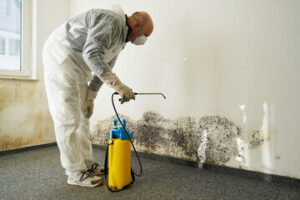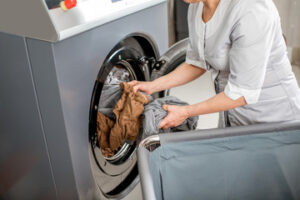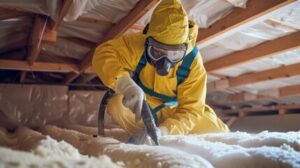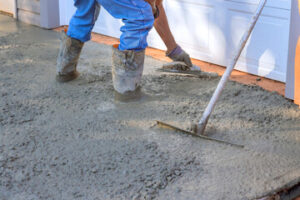A good roofing contractor can perform a thorough inspection to identify any issues. Then, they can recommend the right repair solution.

Leaks, indicated by water stains on ceilings and walls, can compromise the structure of your home. Localized storm damage and flashing problems (the thin metal that surrounds pipes, vents and skylights) may be addressed with targeted repairs. Contact Roof Repair Expert LLC for professional help.
Your roof’s primary function is to protect your home from harsh weather conditions. This includes scorching sun, torrential rain, heavy snowfall, and gusting winds. Aside from shielding your house’s inhabitants from the elements, it also channels water and melting snow away from the foundation of your house, preventing water infiltration and rot that can compromise your property’s structural integrity.
Aside from shingles, the roof’s protective barriers include underlayment and a membrane and vapor barrier that help prevent water leaks and air infiltration. These components should be inspected regularly to ensure they are in good condition and functioning as intended. If a minor problem is left unattended, it can lead to extensive and costly damage in the future.
The gutters and downspouts that channel rainwater and melting snow away from your house should be checked regularly for blockages, as they can contribute to basement flooding and erosion. If you don’t want to deal with these issues, consider rerouting your gutter system and installing downspout extensions. It’s also a good idea to lay out tarps to protect foundation plantings and shrubs during roof tear-off and replacement.
The cost of repairs
The cost of repairing or replacing your roof will vary depending on the type and extent of damage. A comprehensive inspection is the best way to assess the condition of your roof and determine whether repairs or a complete replacement are necessary. The cost of a new roof may seem daunting, but it will save you from recurring repair bills and add value to your home.
The location of your roof can also impact the cost of repairs. Different areas have varying labor rates and the availability of materials. Additionally, different counties and cities might have different permit fees that can add to the overall cost of the project.
Minor repairs can range from patching a hole to repairing a leaky vent. The cost of these repairs can vary widely, but they are usually fairly inexpensive and can be done by the homeowner with minimal professional assistance. Larger repairs, such as replacing shingles or repairing flashing, are more costly and typically require the expertise of a professional.
In addition to addressing damaged roofing materials, you should consider how frequent repairs will affect your property’s value and resale prospects. Often, prospective buyers expect newly-repaired homes to have a roof with resilient materials that will withstand future harsh weather.
A local roofer can advise you on the appropriate solution for your situation. Whether you choose to repair or replace your roof, regular maintenance can prevent problems and extend the life of the structure. For example, clogged gutters can lead to water damage and should be regularly cleaned. Keeping trees trimmed can avoid branches falling onto your roof and causing damage. Having an attic properly insulated will also save energy costs and help reduce the risk of ice dams.
The time of year
The primary function of a roof is to protect the interior of a home from harsh weather conditions. Damage to the roof can compromise this purpose, resulting in leaks and water damage within the home. It is important to schedule repairs as soon as they are necessary to prevent further deterioration.
The best time to perform roof repairs is in spring or summer. This is because the temperatures are mild and this makes it easier for roofing contractors to work on the roof without being affected by the harsh conditions.
Furthermore, the long daylight hours during these seasons make it easy for roofing contractors to work longer each day, expediting the repair process. This also helps ensure that homeowners receive timely service, which is essential for minimizing disruptions to their daily lives.
In addition, the warm weather allows for roofers to install new insulation and ventilation components to improve energy efficiency. This can help reduce air conditioning costs and save homeowners money in the long run.
It is important to inspect your roof regularly for signs of damage and wear. If left unattended, even small issues like missing shingles or cracked tiles can worsen over time and cause significant problems for the rest of the roof. Regular inspections and timely repairs can protect your home from further deterioration and costly damage.
The most common reason for a roof repair is damaged shingles or tiles. Shingles and tiles are durable but they are not infallible, and it is common for high winds, heavy rains, and falling debris to damage or loosen them.
Accessibility
In some cases, roof repairs may be difficult to complete because of access restrictions. This can be especially challenging in healthcare facilities, where contractors must limit disruptions to patients and staff. The accessibility of a roof also impacts the overall cost of the project. For example, a repair team may need to rent or purchase access equipment such as ladders or scaffolding to complete the work safely. These expenses can add up quickly and significantly affect the final cost of the project.
Choosing the right roofing materials is another major factor that can influence the price of roof repair. For example, asphalt shingles are an affordable option for many homeowners, while premium materials like slate or tile are more expensive but offer longevity and aesthetic appeal. The size of a roof also influences costs, as larger areas may require more material and labour to repair.
Before starting any repair work, it is important to ensure that the damaged area is clean and dry. This step is crucial for ensuring that adhesives bond properly. Failure to do so could lead to leaks or other problems in the future. A thorough visual inspection is also essential to assess the extent of the damage and determine how to proceed with the repairs. The process should be completed safely to avoid injuries. Lastly, the location of a property can affect repair costs, as different regions have varying labour and material prices.
Materials
Choosing the correct materials plays a critical role in roof repair and maintenance. Using the right materials ensures that repairs are watertight and durable. This is particularly important in areas that experience heavy rains and snowfall. Choosing quality materials also helps reduce maintenance costs over time. In addition, proper application techniques help maximize the lifespan of the patched area.
The first step in repairing your roof is to inspect the damage. This includes examining the shingles for cracks, curling, or missing pieces. It is also important to examine the flashing, especially around chimneys and vents. This is a common place for leaks to occur. In addition, a careful inspection of the gutters is essential to avoid blockages. Leaking areas should be addressed immediately to prevent further damage. It is also important to trim overhanging branches to prevent them from catching on the roof during storms. Additionally, it is important to have proper attic ventilation to prevent heat and moisture buildup.
When it comes to repairing a leaky roof, there are several different materials that can be used. A roofing company can help you decide which materials are best for your home. Asphalt shingles are inexpensive and easy to install, while metal sheets offer greater durability. Both options are available in a variety of colors to match any home design.
During the repair process, it is important to use the right tools and wear protective gear. A hard hat and face mask protects against debris, and rubber gloves protect the skin from sharp edges. It is also a good idea to have an emergency plan in case a problem occurs. This can include putting buckets or containers in the attic to catch dripping water and securing the damaged area with a waterproof tarp. This will provide a temporary fix until further repairs can be made.








